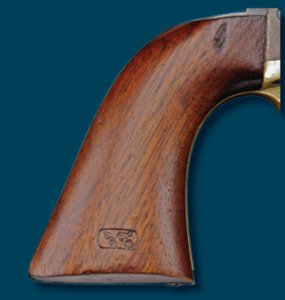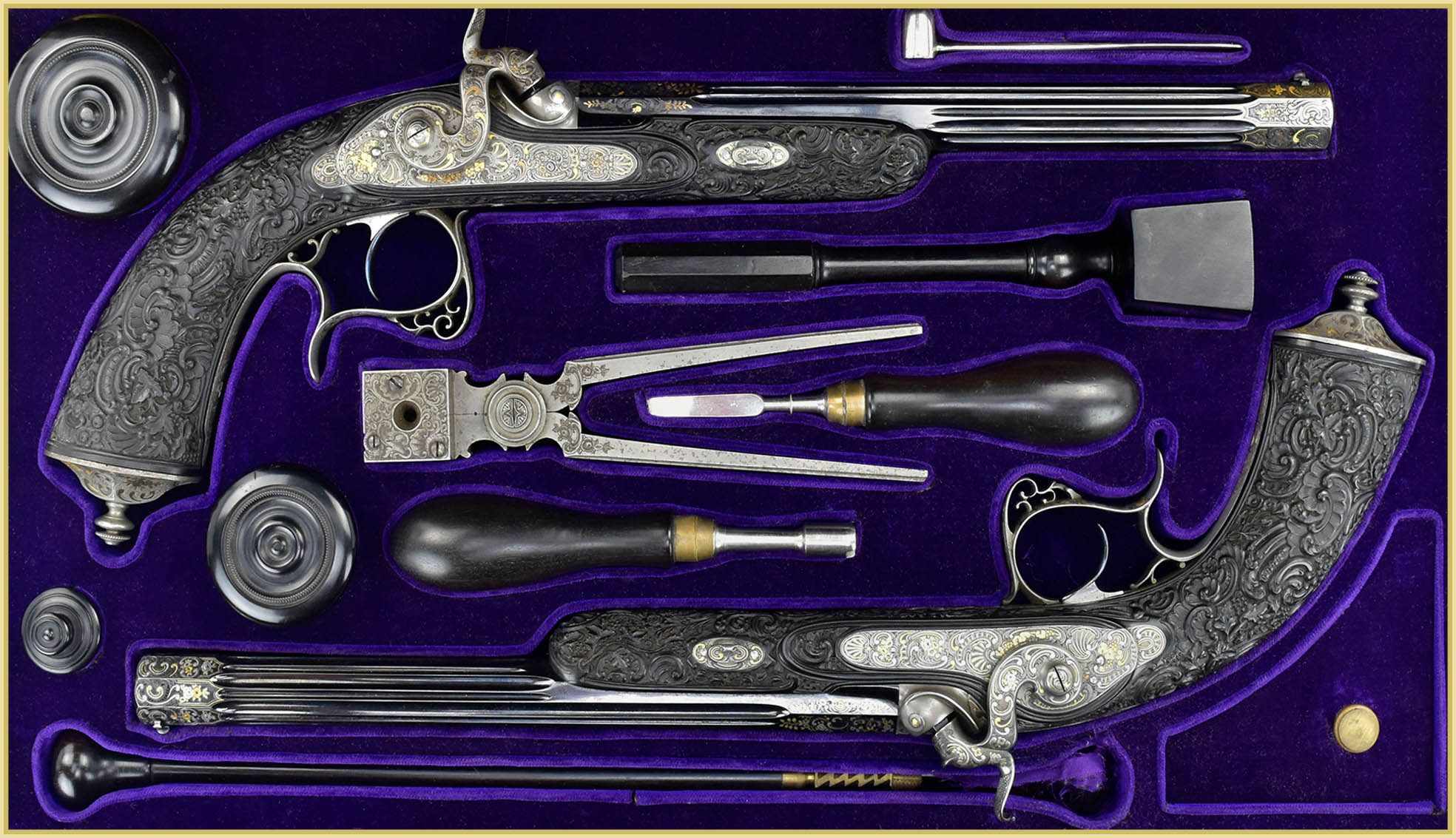Inspector Cartouches on Colt Model 1860 Army Revolver
By Charles Pate Photographs courtesy of James D. Julia, Inc.
The Colt Model 1860 Army revolver was easily the most popular handgun of the American Civil War. Its supremacy was virtually unchallenged until the introduction of Remington’s New Model Army and even afterwards most soldiers preferred the Colt. And today, even though they were manufactured in great numbers, they are still highly desirable collectors items, especially those that have clear military inspection marks.

Approximately 130,000 Model 1860 Colts were purchased for the Union, and of these, 125,8571 were purchased under contracts that required their inspection in detail, and the consequent marks that showed they had passed this inspection. In the majority of cases, the ravages of time and hard use have usually erased some of these inspection marks, and one major factor in determining the value of any specific example is whether or not the most fragile of these marks are still present and legible – the cartouches on the wooden grips. Obviously, whether or not the cartouche is present is easily determined. But the legibility of a cartouche is another matter. Even if the marking is strong and clear, it is often hard to read due to the elaborate styles of lettering used. Combine these factors with a rather large number of variations, and it’s easy to see why there is sometimes considerable difficulty in reading these markings.
The author has collected considerable data on these markings during the process of preparing a book on the Model 1860 Colt and presents his findings here in the hopes that the information will aid in the identification of all the variations and, hopefully, the inspectors whose initials were placed on the pistols. First, however, the reader should understand the roles of the various men involved in the inspection of the Colt Army revolvers, the process they used, and how that process and those roles related to the markings on the pistols.
Generally speaking, there were three categories of “inspectors” participating in the inspection process: the Inspecting Officer (IO), an Army officer who was authorized to give final inspection approval and receive the pistols as government property; the Principal Sub-inspector (PSI), the senior civilian inspector present who was in charge of the day-to day inspection at the contractor’s facility; and the Sub-inspectors (SI), highly experienced, reliable and capable civilian workmen selected by the IO to actually perform the inspection.
The inspection process has been addressed in detail in other previously published articles and will be only summarized here, since only parts of it relate to inspector cartouche markings, the subject of this article.2 Briefly stated, the process began with proof firing and marking of the barrel and cylinder to show the pistol had passed this test. Next, each component part was critically inspected to ensure conformance with the approved model and that the part was acceptable in both material and workmanship. After passing these tests, the revolver was once again assembled and given a “final inspection.” Normally, the process called for the PSI to examine the assembled pistol to determine if it was ready for the IO’s examination and, if so, he would mark the left side of the grip with a cartouche containing his initials. The IO usually did not visit the contractor’s facility until he had been advised by the PSI that a set number of pistols, usually 300-500, were ready. With the PSI present, the IO performed the final examination and “received” the pistol if it met with his approval. He marked those pistols that he accepted on the right of the grip with a cartouche containing his initials.3 The IO would then certify acceptance to the appropriate government authorities, who would pay the contractor according to the terms of the contract.
That is how the process was supposed to work, but naturally, the crisis brought on by the war required some modification. However, the need for expedited procedures was not immediately apparent. The correspondence of Major R. H. K. Whiteley, the IO during the first few months of the war, indicates he was attempting to do business as usual. But the demands for his time precluded him from always being present for the final inspection. His cartouche is present on very few surviving examples, and in some cases, he is known to have told the PSI to conduct the final inspection without him.
Captain George T. Balch replaced Major Whiteley as the IO for Colt inspections in mid-September, and while he may have attended some of the final inspections, no Model 1860 revolvers have been noted bearing his initials.4 All of the Colt pistols delivered while Captain Balch was the IO have cartouches only on the left of the grip. Balch’s correspondence shows that he was using John Taylor as his principal assistant inspector, but there are a variety of inspector cartouches on pistols delivered in this period, which ended in mid April 1962.5 This probably reflects the facts that Taylor had additional duties as well as the confidence held in some of the other sub-inspectors then present – men like Joseph and Benjamin Hannis, O. W. Ainsworth, and Pomeroy Booth.
As many as eleven sub-inspectors were assigned to inspection at Colt on occasion and several of the best of them were sent to other manufacturers as the principal sub-inspectors at those facilities. The Army would replace those men with less experienced inspectors and, in some cases, subsequently use them elsewhere after they had gained greater experience and the confidence of the officers.

Due to problems in completing 2000 Sharps rifles for Colonel Berdan’s Sharpshooters, John Taylor was placed in charge of their inspection in early April 1862. He took with him several of the inspectors then at Colt in an attempt to expedite delivery of the rifles. At about this same time, there was a short hiatus in the delivery of Colt revolvers caused by the Holt-Owen Commission investigation of arms procurement practices. None were delivered in May, and when deliveries resumed on the 9th of June, a change had been made in procedures. Pistols delivered on that date, and subsequently, once again had a cartouche stamped on the right of the grip. However, this cartouche was also that of a civilian, usually the “JT” of John Taylor. This may have resulted from recommendations that Captain Balch had made near the close of his IO duties, in which he called for “a more rigid system of inspection.” It is interesting to note that Taylor’s cartouche leaned to the left. The cartouche with left-leaning letters predominates in the 40,000 to 85,000 serial number ranges. A cartouche with the letters once again leaning to the right reappears at approximately 75,000 and is the most common “JT” cartouche beginning at about 85,000.
These cartouches, and others noted on Colt Model 1860 revolvers, are illustrated here through excellent drawings provided by Mr. Anthony Daum, to whom the author is thankful. Hopefully, knowing what the designs look like will facilitate the identification of specimens that are worn and only partially legible.

There are undoubtedly some errors in the data presented in this article and some anomalies that cannot presently be explained. The author would welcome additional data from the readers in his attempt to make this material more definitive.

